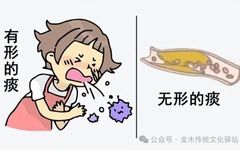
What is “Phlegm-Dampness” in Traditional Chinese Medicine (TCM), how is it formed in the human body, how to identify and analyze the strange diseases caused by phlegm-dampness, and how to choose appropriate treatment methods and herbal formulas.
What exactly is phlegm-dampness in TCM, and what strange diseases can it cause?
Phlegm-dampness is formed due to the decline of the spleen’s ability to transform and transport water and dampness, or when the circulation and excretion of body fluids are obstructed. This leads to abnormal accumulation of fluids in the body, which is termed “Phlegm-Fluid” in TCM.
The turbid, viscous, and thick part is called “Phlegm”, while the clear, thin, and transparent part is referred to as “Fluid”.
Therefore, the term “Phlegm” in TCM does not simply refer to the phlegm produced in the lungs that can be expelled through coughing and is visible to us. TCM’s concept of “Phlegm” also includes pathological products that arise from metabolic disorders of body fluids, characterized by turbidity, viscosity, and thickness.
For example, obesity is referred to as “Phlegm” in TCM. Since this type of “Phlegm” is not as easily recognized as the phlegm in the lungs, it is termed “Invisible Phlegm”, while the phlegm produced in the lungs that can be expelled through coughing and is visible is called “Visible Phlegm”. Together, these two concepts form the TCM understanding of “Phlegm”.
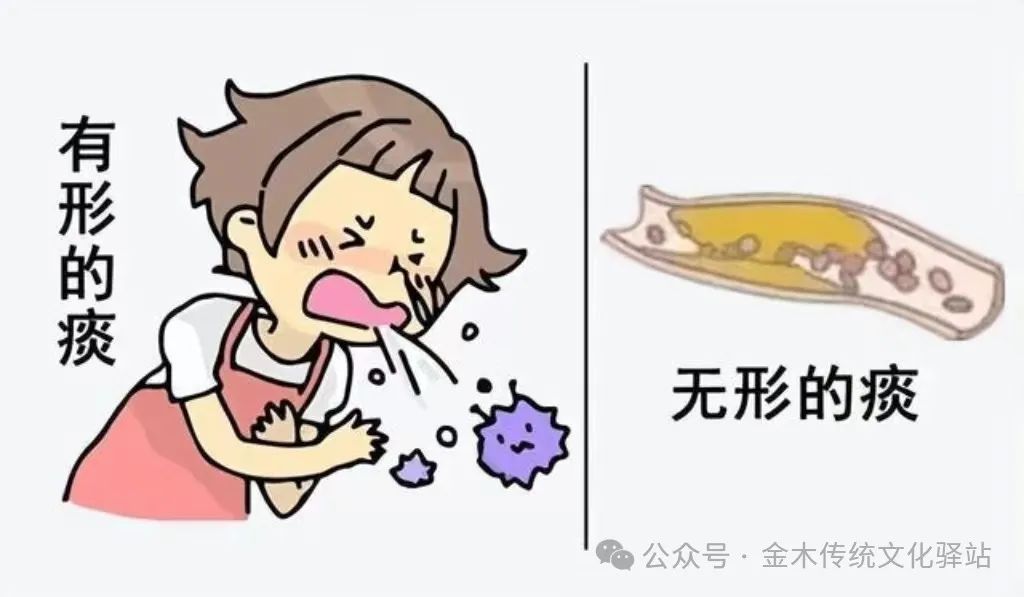
“Visible Phlegm” primarily exists in the lungs and may be produced by the body’s own metabolic disorders of fluids or by external pathogenic factors invading the lungs. This type of phlegm can be expelled through coughing and is observable, making it easier to understand.
We are quite familiar with “Visible Phlegm”, as we often encounter it during colds and coughs. However, have we noticed a detail: even though the phlegm coughed up from the lungs is the same, there are various differences in its characteristics?
For instance, some phlegm is white and viscous, some is thin and white, some is foamy, some is yellow and thick, some is gray-black, and some is yellow-green… Why does the same phlegm exhibit so many variations?
Upon careful analysis, the various characteristics of phlegm can be summarized into two aspects:
First, there are differences in texture: thick, thin, or foamy;
Second, there are differences in color: white, gray-black, yellow, or yellow-green.
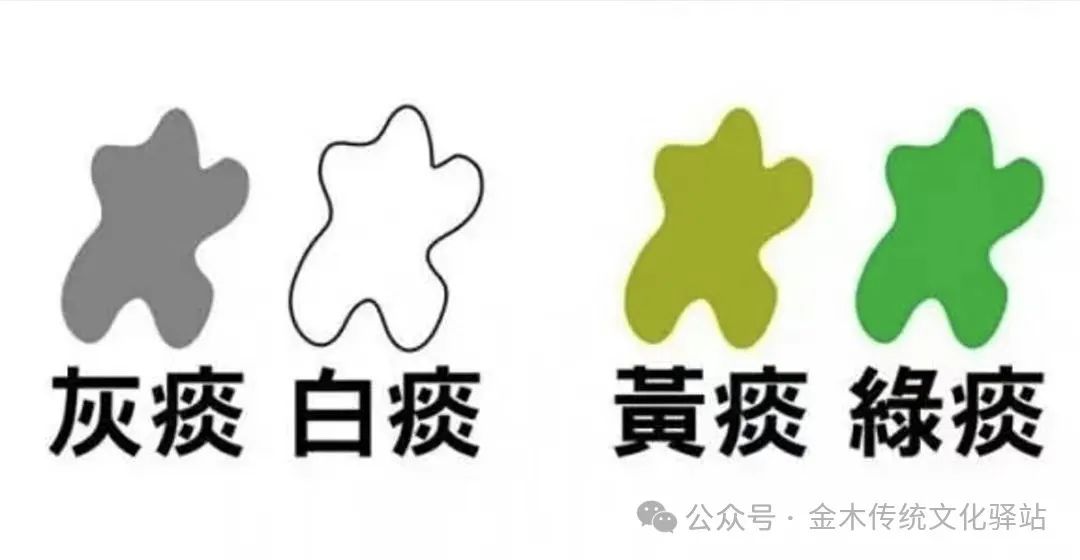
1. What do the different textures and colors of phlegm mean?
Let’s consider a common phenomenon: dissolving sugar in water. We obtain a colorless and transparent liquid. If we heat this sugar water, what will happen? We can see that the sugar water gradually becomes thick, and its color changes from transparent to light yellow, then to deep yellow.
This phenomenon can be extrapolated to the phlegm in the body. The thickness and color of phlegm are closely related to the body’s internal “heat”. If there is heat in the body, the phlegm will be yellow and thick; if there is no heat, the phlegm will be thin and white. The higher the degree of yellow thickness, the higher the degree of internal heat.
According to this principle, TCM categorizes white, thin, or foamy phlegm as “Cold Phlegm”, while yellow and thick or even yellow-green phlegm is categorized as “Heat Phlegm”.
Since Cold Phlegm and Heat Phlegm reflect completely opposite natures, their treatments are also entirely different. Cold Phlegm treatment requires warming and transforming it, commonly using herbs such as Gan Jiang (Dried Ginger), Xi Xin (Asarum), Jiang Ban Xia (Pinellia), Chen Pi (Aged Tangerine Peel), Bai Jie Zi (White Mustard Seed), and Lai Fu Zi (Radish Seed); while Heat Phlegm treatment requires clearing heat and transforming phlegm, commonly using herbs such as Zhe Bei Mu (Zhejiang Fritillaria), Chuan Bei Mu (Sichuan Fritillaria), Tian Zhu Huang (Bamboo Shavings), Dan Nan Xing (Arisaema), Gua Lou (Trichosanthes), and Tian Hua Fen (Trichosanthes Root).
However, whether it is Cold Phlegm or Heat Phlegm, TCM emphasizes the concept of “transformation” in treatment. What does “transformation” mean? In the past, before the advent of running water, if the water quality was murky, we often added a small amount of alum to the water tank, and after a while, the water would become clear. The alum played a role in breaking down and settling the turbid substances in the murky water, which is the essence of “transformation”.
The phlegm-transforming herbs used in TCM for various phlegm conditions are analogous to the role of “alum”, capable of breaking down and settling the turbid phlegm, thus eliminating diseases caused by phlegm-dampness.
Western medicine also recognizes phlegm in two categories: one is infectious phlegm, such as that caused by bacterial, fungal, mycoplasma, or chlamydia infections; the other is exudative phlegm, often formed due to excessive secretion of mucus by respiratory mucosal cells.
In this case, antibiotics can be effective against phlegm caused by bacterial infections, while there are limited options in Western medicine for phlegm caused by fungal, mycoplasma, or chlamydia infections, as well as exudative phlegm. How does TCM view and treat these phlegm-related diseases?
TCM believes that microorganisms such as fungi, mycoplasma, and chlamydia naturally exist in the air and do not harm the body under normal circumstances. Only when there is excessive accumulation of water and dampness in the body, creating an overly humid internal environment, do these microorganisms proliferate and reproduce, thereby harming human health and causing various diseases.
Therefore, for these types of diseases, the internal environment’s “humidity” is the true root cause. Just like in the rainy season, the humid environment allows fungi to proliferate, making things prone to mold. If you can recognize that the humid environment is the main reason for fungal proliferation in natural phenomena, isn’t the human body the same?
So how should we treat phlegm caused by internal humidity? In daily life, humidity is often associated with overcast and rainy weather. If the sky is clear and sunny, there will naturally be no humid environment.
There is a saying: “When the sun is high, the haze dissipates”, which illustrates this principle. The scorching sun can drive away humidity, primarily relying on its heat. Therefore, when treating this type of phlegm, we should use warming herbs to create a “scorching sun” effect in the body, allowing the humid “haze” to dissipate;
This eliminates the root cause of water and dampness accumulation in the body, preventing the environment for the survival and reproduction of fungi and other microorganisms, thus providing quick efficacy against phlegm caused by fungi, mycoplasma, chlamydia infections, and exudative phlegm.
The Han Dynasty medical sage Zhang Zhongjing already proposed in the “Jin Gui Yao Lue” that the principle for treating this disease is “For those with phlegm-fluid, one should use warming herbs to harmonize it”, which still seems remarkably insightful today. This makes us sincerely admire the ancient methods and thoughts of exploring the mysteries of life and disease.
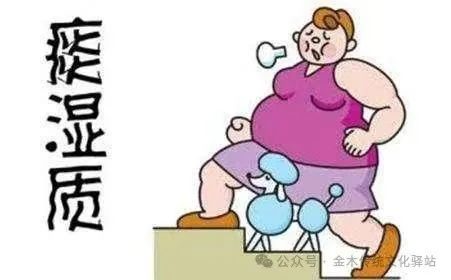
2. Invisible Phlegm
Having discussed Visible Phlegm, what is “Invisible Phlegm” and how can we determine its existence? TCM identifies the presence of “Invisible Phlegm” based on four criteria.
① Obesity
In TCM, it is said that “obese individuals have much phlegm-dampness”, referring to the presence of “Invisible Phlegm” in obese individuals, as fat possesses the characteristics of “Phlegm”—turbidity, viscosity, and thickness. It is formed from the turbid parts of accumulated water and dampness in the body.
② Thick and greasy tongue coating
A thick and greasy tongue coating is the most direct manifestation of excessive water and dampness in the body.
③ Tumors
Any tumor that is not red, protrudes from the skin surface, is nodular, and feels soft or resilient upon palpation, is referred to as a “Phlegm Mass” in TCM.
④ Slippery pulse
In TCM, the pulse is classified into more than twenty types based on different sensations felt under the fingers, with the slippery pulse being one of them. The description of a slippery pulse in TCM is “flowing smoothly, like pearls rolling on a plate”, indicating that the pulse feels as smooth and swift as pearls rolling on a smooth surface. The presence of a slippery pulse is one of the characteristic manifestations of internal phlegm-dampness and is a major basis for TCM diagnosis of “Phlegm”.
Based on TCM’s understanding of phlegm, combined with Western medicine’s microscopic examinations, the concept of “Invisible Phlegm” can be made more concrete and intuitive. For example, conditions such as hyperlipidemia, cysts, lymph node tuberculosis, and bone tuberculosis all exhibit characteristics of turbidity, viscosity, and thickness, and can thus be considered phlegm-related diseases. In this way, Western medical examinations extend the TCM diagnostic methods of observation, listening, inquiry, and palpation.
Through TCM’s understanding of the mechanisms of phlegm formation, we can relate the occurrence of these diseases to the overall balance state of the body, finding fundamental treatment methods for these diseases.
For instance, hyperlipidemia, cysts, and lymph node tuberculosis all conform to the characteristics of TCM phlegm. The fundamental cause of their occurrence is related to the spleen’s dysfunction in transformation and transportation, leading to excessive accumulation of water and dampness in the body. Therefore, treatment can be approached by strengthening the spleen, assisting its function, and transforming phlegm to soften hard masses. Moreover, by eliminating the generation of “Phlegm” from the root, the treatment effect is long-lasting.
The spleen’s insufficient ability to transform and transport water and dampness leads to the accumulation of water and dampness in the body. The turbid substances in the water and dampness can condense into phlegm masses in certain areas of the body, such as cysts, lymph node tuberculosis, and bone tuberculosis. They can also enter the meridians and blood vessels, traveling throughout the body with the circulation of qi and blood, as mentioned earlier regarding blood lipids. These turbid substances have viscous characteristics, often leading to obstruction of qi and blood flow in the meridians and blood vessels, causing pathological changes due to ischemia and hypoxia in the organs, resulting in various diseases. For example, if phlegm accumulates in the head, it can affect blood supply to the brain, leading to symptoms such as dizziness, forgetfulness, drowsiness, and even coma, hemiplegia, and speech difficulties, which Western medicine refers to as cerebral infarction. Many cases in TCM are attributed to phlegm.
If phlegm accumulates in the limbs, it can lead to blood supply disorders in the limbs, resulting in symptoms such as numbness in the limbs and cold extremities. If phlegm accumulates in the blood vessels, it can lead to insufficient blood supply to the heart, causing symptoms such as palpitations, anxiety, irregular heartbeat, and chest tightness, which in many cases are closely related to phlegm, as described in Western medicine as coronary heart disease.
Additionally, phlegm can also affect a person’s mental state. If the turbid qi of phlegm-dampness obstructs normal mental and cognitive activities, it can lead to symptoms such as excessive talking, depression, and unexplained sadness, which are classified as depressive mental disorders. Since TCM believes that the “Heart” governs the mind, this type of mental disorder caused by excessive “Phlegm-Turbidity” is referred to as “Phlegm Obstructing the Heart Orifices”.
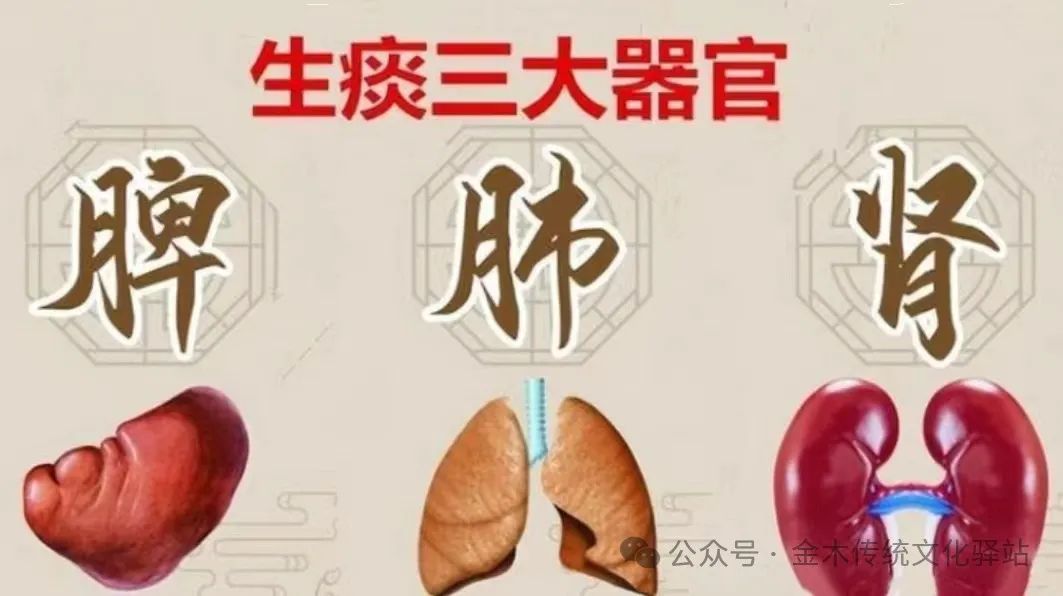
3. The Mobility of Phlegm
Regarding the mobility of phlegm, the great physician Zhu Danxi from the Yuan Dynasty stated: “Phlegm, as a substance, rises and falls with qi, reaching everywhere.” It is precisely because of the characteristic that phlegm “reaches everywhere” that TCM attributes many strange diseases or diseases with poor treatment outcomes to “Phlegm”.
Thus, there is a saying in TCM: “Strange diseases often arise from phlegm.” Zhu Danxi also proposed the theory that “many diseases are accompanied by phlegm”, which provides new insights for diagnosing and treating diseases. Some diseases may have correct differentiation and appropriate medication, but the clinical outcomes are not ideal. In such cases, we can consider adding phlegm-transforming methods, which often yield unexpectedly good results.
4. The Strange Disease of Ménière’s Disease is Also Caused by Phlegm-Dampness
Here, I would like to mention Ménière’s disease (formerly known as Meniere’s disease).
The clinical features of this disease include: paroxysmal dizziness that occurs frequently, during which the patient feels that surrounding objects are spinning, as if sitting on a vehicle that is swaying, accompanied by nausea, vomiting, and headache, with activities exacerbating the severity of dizziness and vomiting.
Therefore, during an episode, patients often lie still with their eyes closed, afraid to move. Some patients may feel a sense of blockage and pressure in the ear, or experience nystagmus.
Western medicine believes this disease is caused by increased lymphatic fluid and elevated pressure in the inner ear, leading to ear-related dizziness.
According to Zhang Zhongjing’s records in the “Jin Gui Yao Lue” regarding the “Mao Xuan” syndrome (“Mao” refers to nausea and vomiting, and “Mao Xuan” refers to a disease characterized by dizziness, nausea, and vomiting occurring simultaneously), Zhang Zhongjing believed it was caused by “Fluid in the Heart”, which closely resembles Ménière’s disease.
Zhang Zhongjing’s records suggest that this disease is caused by water and fluid stagnation in the inner ear, and he used the “Ze Xie Decoction” from the “Jin Gui Yao Lue” for treatment, achieving excellent clinical results.
The composition of Ze Xie Decoction consists of two herbs—Ze Xie (Alisma) and Bai Zhu (White Atractylodes). Ze Xie is recorded in the “Shen Nong’s Herbal Classic” for its efficacy in “relieving wind, cold, dampness, and eliminating water”; Bai Zhu, as mentioned in the “Record of Famous Physicians” by the Jin Dynasty physician Tao Hongjing, is said to “eliminate phlegm and water, expel wind-water swelling”, and is also noted for its ability to “warm the stomach and eliminate food stagnation”.
These two herbs work together: Ze Xie primarily promotes urination to eliminate internal water and fluid, while Bai Zhu assists in strengthening the spleen and eliminating phlegm-water. This combination effectively addresses both the symptoms of water and fluid accumulation and the root cause of phlegm production due to spleen deficiency, resulting in rapid therapeutic effects despite the small number of herbs.
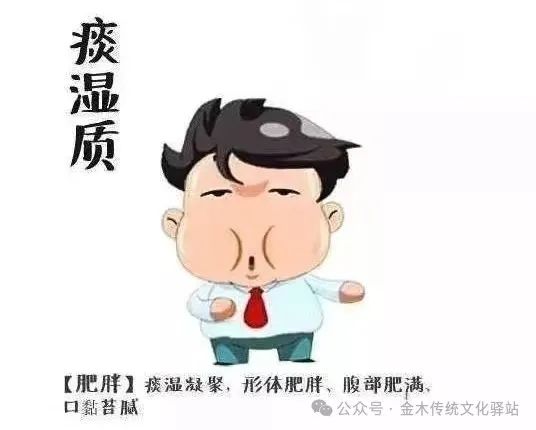
Self-Assessment for Phlegm-Dampness Constitution:
(1) Dizziness, headache, and heaviness in the head:
In TCM, the head is the residence of the clear and ethereal, where the original spirit resides, requiring nourishment from qi, blood, and essence, and should not be disturbed by turbid evils. If phlegm-dampness invades upwards, it obstructs the clear, leading to dizziness, headache, and a feeling of heaviness.
Headaches and dizziness that belong to the category of excess are often seen in hypertension.
Western medicine believes that hypertension is caused by spasms of cerebral blood vessels or loss of elasticity due to vascular hardening, leading to obstruction of blood flow and increased pressure.
From a TCM perspective, the turbid evil of phlegm-dampness is heavy and tangible, and combined with the characteristic of “Phlegm being a problem that rises and falls with qi, reaching everywhere”, phlegm-dampness invading upwards obstructs the clear yang, filling and blocking the blood vessels, which can also lead to vascular spasms and loss of elasticity, resulting in elevated blood pressure.
Therefore, for hypertensive patients who exhibit symptoms of phlegm-dampness obstructing the clear yang in the head, treating them with methods to clear and transform phlegm-dampness can yield significant results.
Dizziness, headache, and heaviness in the head caused by phlegm-dampness may either persist or fluctuate, but they are fundamentally different from symptoms caused by qi and blood deficiency. Using tonics is not only ineffective but may also worsen the condition, as it is due to the obstruction of tangible evils.
(2) Phlegm-Dampness Constitution:
Refers to a condition where the functions of the body’s organs are disordered, easily leading toqi, blood, and body fluidtransportation disorders, resulting in the accumulation of water and dampness, which manifests as phlegm-dampness. Common symptoms include obesity, fullness in the abdomen, chest tightness, excessive phlegm, easy fatigue, a heavy and uncomfortable body, a preference for rich and sweet foods, a large tongue, and a thick white greasy tongue coating;
It is often caused by invasion of cold and dampness, irregular diet, congenital constitution, aging, chronic illness, and lack of exercise. Symptoms may vary depending on the location of phlegm-dampness retention, with a tendency to develop conditions such as diabetes, stroke, and chest obstruction, and poor adaptability to rainy and humid environments. The main treatment principle is to dry dampness and transform phlegm, with regular attention to improving phlegm-dampness constitution to prevent the occurrence of phlegm-dampness diseases.
Phlegm-dampness constitution often arises from various causes leading to dysfunction of the organs’ qi transformation, resulting in disordered transportation of qi, blood, and body fluids, accumulation of water and dampness, and retention of phlegm-dampness, which in turn affects organ function.

(3) Common Causes of Phlegm-Dampness Constitution:
A. Invasion of Cold and Dampness
Humid climate, exposure to rain, or prolonged residence in damp areas can lead to dampness invading the body, causing the spleen and stomach to be obstructed, impairing the transformation of water and dampness, resulting in accumulation of dampness and phlegm in the lungs.
B. Irregular Diet
Frequent overeating, excessive consumption of rich and sweet foods, can damage the spleen and stomach, preventing the distribution of the essence of food and the transformation of water and dampness, leading to internal dampness and the formation of phlegm.
C. Congenital Constitution
Individuals with a constitution prone to stomach heat, who frequently consume rich and sweet foods, may experience impaired spleen function, leading to dampness accumulation and phlegm formation.
D. Aging and Chronic Illness
Weakness of the spleen and stomach, reduced transformation function, or kidney yang deficiency can impair the ability to transform qi and transport water.
E. Lack of Exercise
Long-term preference for lying down or sitting with little movement can lead to poor circulation of qi and blood, sluggish spleen and stomach function, and inability to transform water and dampness, resulting in internal phlegm-dampness.
Individuals with phlegm-dampness constitution often exhibit a body shape that is overweight, fullness in the abdomen, chest tightness, excessive phlegm, easy fatigue, a heavy and uncomfortable body, a preference for rich and sweet foods, a large tongue, and a thick white greasy tongue coating. Symptoms may vary depending on the location of phlegm-dampness retention, with a tendency to develop conditions such as diabetes, stroke, and chest obstruction, and poor adaptability to rainy and humid environments.
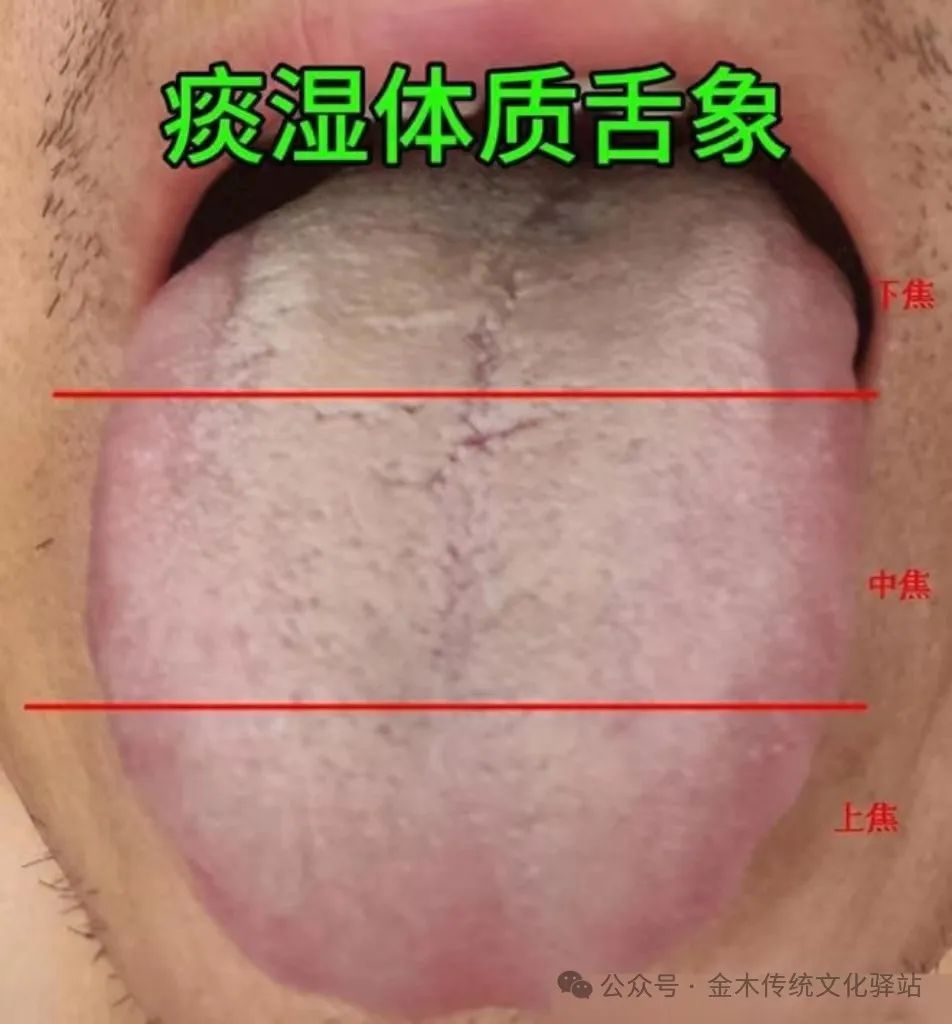
(4) Diagnostic Methods for Phlegm-Dampness Constitution:
A. Phlegm-Dampness in the Lungs
Manifestations: Recurrent cough, excessive sticky or thick phlegm, white or grayish in color, worsened by sweet and greasy foods, fatigue, thick greasy tongue coating, slippery pulse.
Regulation: Dry dampness, transform phlegm, warm the lungs, and descend rebellious qi.
B. Phlegm-Dampness Obstructing the Middle Jiao
Manifestations: Abdominal fullness and discomfort, especially after eating, chest tightness, dizziness, heaviness and fatigue, nausea and vomiting, poor appetite, bland taste, normal or loose stools, thick greasy tongue coating, and submerged slippery pulse.
Regulation: Dry dampness, transform phlegm, regulate qi, and harmonize the middle jiao.
C. Phlegm-Dampness Obstructing the Orifices (Phlegm Obstructing the Clear Orifices)
Manifestations: Heaviness and foggy head, chest tightness, nausea, vomiting phlegm, poor appetite, excessive sleepiness, thick greasy tongue coating, and submerged slippery pulse.
Regulation: Dry dampness, transform phlegm, strengthen the spleen, harmonize the stomach, and pacify the liver to calm wind.
Symptoms of phlegm-dampness constitution are diverse, and the main treatment principle should focus on drying dampness and transforming phlegm.
(5) Prevention and Health Maintenance for Phlegm-Dampness Constitution:
Individuals with phlegm-dampness constitution should develop good dietary habits, avoiding rich, sweet, cold foods, quitting smoking and alcohol, and regularly consuming ginger, vegetables, and fruits rich in fiber and vitamins to maintain smooth and normal bowel movements.
Since “the spleen is the source of phlegm, and the lungs are the storage for phlegm”, individuals with phlegm-dampness constitution should avoid exposure to water and rain, prolonged residence in damp areas, pay attention to warmth, and prevent external cold and dampness from harming the spleen, especially during the rainy season when humidity is high. Engaging in appropriate physical exercise is also recommended, aiming for mild sweating to promote smooth circulation of qi and blood.
Spread knowledge of TCM health preservation, promote traditional Chinese culture,share health concepts, and convey care, passing on health knowledge and traditional culture to more friends…
People are great because they have dreams; we are different because we have love.
Liu Qing Ning: 182 7127 1941 or (WeChat ID)
Yang Shun Song: 138 7171 7447 or (WeChat ID)


